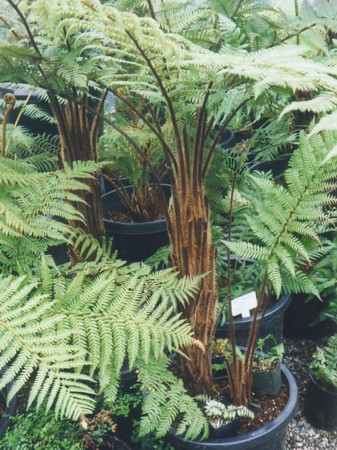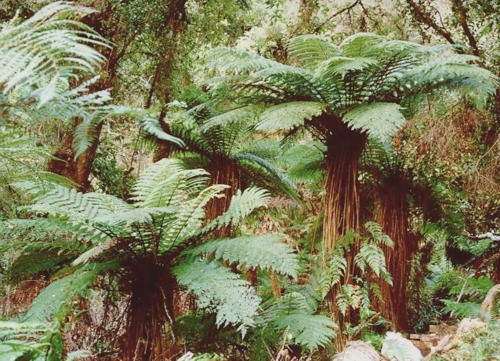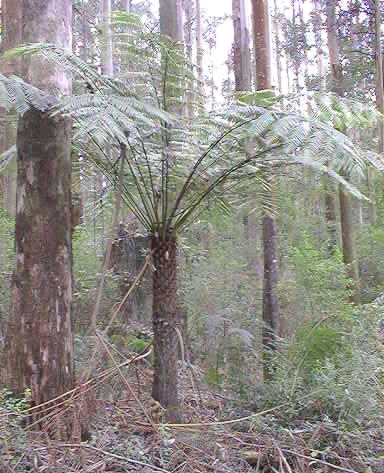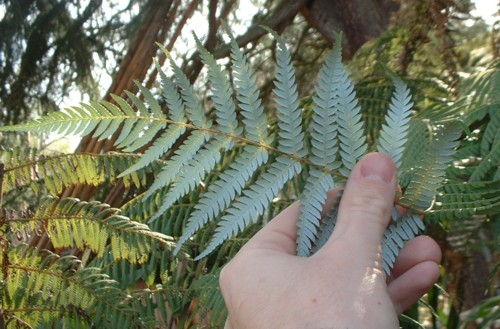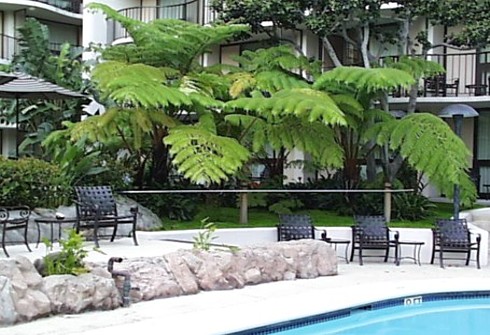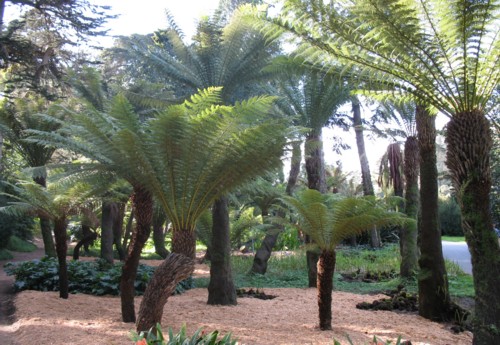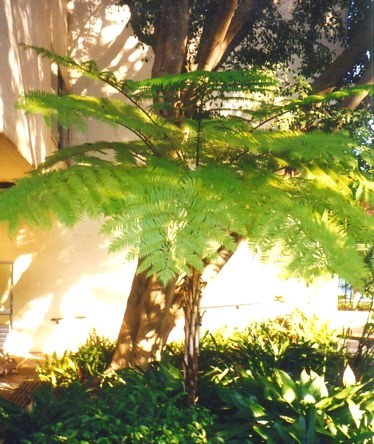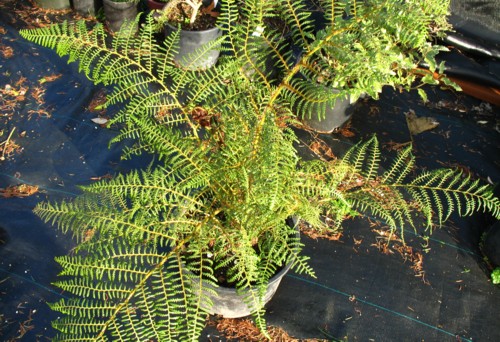Tree Ferns in the Pacific Northwest
This article first appeared in HPI Editions #44 and 45 in late 2000 and early 2001. I have given it a major revision in February 2007, as much new information about tree ferns has come forth since that time; and, admittedly, my writing style in 2000 needed some refinement! As a young child who knew little about plants, I once had the good fortune of traveling to New Zealand. Although I can recall little from that trip today, one lasting memory I retained was one of gazing in awe at ferns that grew tall trunks and held their fronds high above my head. In later years, I discovered that these huge ferns are called 'tree ferns'-and, still fascinated with them, I began my search to find tree ferns that I might grow in my own garden. I have now grown tree ferns in Olympia, Washington for several years, and researched many tree fern species extensively. While I have not managed to collect a great number of species due to their scarcity, I feel that my knowledge of tree ferns has become sufficient to assess their potential and limitations as garden plants in our region. Because tree ferns remain scarce in the Pacific Northwest, much of the information in this article comes from correspondents in Australia and Britain, rather than local tree fern growers. Whether or not this information rings true in our environment can only be ascertained by experience over time. The obvious, significant difference between a tree fern and an ordinary garden fern is the presence of a trunk that reaches high into the sky, holding the fronds (the name for fern leaves) high at the top. The tree fern trunk has a very different structure than that of our usual woody plants and trees. It consists of a thick woody substance called a caudex, which is formed out of a tangle of roots and other tissues, rather than annual rings of wood. Thus, the trunk does not increase in girth as the tree fern ages, except as more aerial roots coat its surface (this is especially apt to occur in a moist environment). The fronds develop continuously and expand from the 'crown' at the top of the trunk, while the trunk gradually increases in height. The crown, then, is the most vulnerable part of the plant: if it is destroyed, the fern will not be able to grow any more fronds (except in those species that produce offsets). Because tree ferns leave their root-covered trunks exposed to the air, the trunk is very vulnerable to drying out, though drought tolerance varies from species to species.
As a general rule, tree ferns perform well where they receive morning sun; but some protection from the hot, drying afternoon sun. Of the two main genera of tree ferns we can grow here, Dicksonia species are all shade tolerant, and will also thrive in some sun if the rest of its growing conditions are ideal; Cyatheas have variable needs depending on the species. Some Cyatheas such as C. cunninghamii and C. smithii require shade and shelter from wind and exposure to thrive. On the other hand, some Cyatheas require sun for good growth, which can limit the positions available to grow them without exposing them to frost. Positioning a tree fern under an overhang or high canopy of trees will aid in frost protection. It also shelters the plant from strong winds, which may damage or dry out the fronds. This replicates their natural forest habitat. Trunk development of most species occurs at a rate that most gardeners would consider to be quite slow. In most cases, the trunk starts to appear about one to three years after the fern is planted from a three or five gallon pot. Dicksonia antarctica and D. fibrosa will typically grow about 1-2" of trunk per year, while some species that produce offsets such as D. squarrosa may grow up to 4" per year. Cyatheas are variable, but the hardier species generally grow at least 2-3" per year, and some less hardy species such as C. brownii over 12" per year (occasionally 24" per year) under good conditions. Young plants begin with small fronds, but new fronds increase in size quickly, resulting in an impressive plant even before the trunk forms. Once trunk development has begun, the fronds may be anywhere from 4 to 20 feet in length, depending on the species and the conditions in which it is growing.
This means that in the Pacific Northwest, tree ferns will need occasional to frequent protection from cold weather, depending on the locale and the species chosen. For the present, it seems that no tree fern can be considered fully hardy for Pacific Northwest gardens unprotected from the cold. However, protecting tree ferns from winter cold needn't be overly difficult if you stick with the hardiest species. A common protection method is to put sawdust or pine mulch (or something similar) into the crown, and wrap the trunks with fiberglass insulation. Young plants with little trunk can simply be covered with some kind of insulative mulch and/or blankets.
The two tree fern species you are most likely to encounter in Pacific Northwest gardens and nurseries are Cyathea cooperi (sold as the 'Australian tree fern') and Dicksonia antarctica (sold as the 'Tasmanian tree fern' ('Tasmanian' is a bit misleading since this species grows throughout the mainland of temperate southeast Australia also). Cyathea cooperi is relatively easy to find, very fast growing, and fun to grow; but it is not really hardy here, and cannot be expected to survive a severe winter without heavy protection. Dicksonia antarctica is hardy enough to grow here with basic protection methods. The fronds of this species will survive temperatures down to about 20°F before they are severely damaged. It usually grows about 1 inch of trunk per year, but it can be compelled to grow 2 inches per year under good conditions, ultimately achieving a height of 20' or higher. The fronds have a coarse, leathery texture; and the upper trunk and fronds have reddish brown hairs. If the fronds are lost in the winter, it will produce a whole new 'flush' of fronds at once in the spring, as long as the crown has not been killed by freezing. (Heavy feeding can encourage this.) I would recommend this species as an excellent tree fern for gardeners wishing to introduce themselves to tree ferns, since it is relatively easy to grow and not too difficult to find in nurseries. Now for a wider overview of tree fern species we may eventually have to choose from for our gardens. I will begin in New Zealand, which contains three endemic species of Dicksonia. D. fibrosa is very similar to D. antarctica, but smaller in overall stature, making it useful where a smaller substitute for D. antarctica is desired. The fronds are slightly coarser in texture than those of D. antarctica. It is at least as cold-hardy as D. antarctica, and also quite easy to grow and overwinter.
The third New Zealand species is D. lanata which is very cold hardy but usually has a prostrate, creeping trunk, and is considered by some to be difficult to grow. New Zealand is home to five species of Cyathea. The most spectacular is C. dealbata, the silver fern, whose fronds have beautiful white undersides. This beautiful species is the floral emblem if New Zealand. In the wild it is a forest-dwelling species preferring a sheltered spot, but it is able to adapt to some exposure. It is hardy to about 24°F, and specimens at Logan Botanical Gardens in Scotland have survived 16°F without protection (at which temperature they were heavily damaged, I am certain).
Cyathea medullaris is also from New Zealand, where it is found in lowland and coastal areas, frequently on very exposed sites. It can achieve large dimensions quickly in cool climates and, if not damaged by frost, rapidly becomes an impressive plant. It has attractive black stipes (the word for fern petioles) and a dark crown, and the fronds may exceed 12' in length. Alas, its cold tolerance is only about 26°F, or perhaps slightly lower. Although it has attracted attention from hardy tree fern enthusiasts, I would not really recommend it as one of the best ones to try in the Pacific Northwest. It does not like losing its fronds and requires a couple years to recover if it is severely damaged. C. cunninghamii is a montane relative of C. medullaris that occurs in both Australia and New Zealand, where it is found occasionally in sheltered gullies. It is a very large fern that may reach 60' tall or more in the wild! Although hardier than C. medullaris, it is very rare in cultivation. It demands a cool, shady situation, but it is very fast growing, and holds promise for Pacific Northwest tree fern enthusiasts. The fifth species, C. colensoi, is very cold hardy but does not usually form much of a trunk. New Zealand also contains many other large and interesting ferns that do not form trunks, and a few trunk forming species of Blechnum.
Australia also contains two other rare Dicksonias. D. youngiae grows in cool moist forests in southeast Queensland. It roughly resembles D. squarrosa in habit and size, but has coarse, reddish-brown hairs rather than the soft brown-grey hairs of D. squarrosa. Despite such a northerly place of origin, it is at least as cold-hardy as D. squarrosa, and should be added to the collection of any tree fern enthusiast who fancies D. squarrosa. The other Australian species is D. herbertii, which grows in moist mountain cloudforests in the north of Queensland. Little information is available regarding its appearance or potential cold-hardiness.
Other Australian Cyatheas worth trying include Queensland's C. celebica, which is a little bit hardier to cold than C. cooperi; and C. leichhardtiana, a forest dweller from the Southeast which is commonly ignored in cultivation though it may be quite hardy. The really adventurous tree fern enthusiast may wish to try C. brownii, from Norfolk Island, which can grow to 100' tall; or C. robusta or C. howeana from Lord Howe Island. These three ferns have similar hardiness to C. cooperi (C. robusta perhaps slightly hardier!) but are far more spectacular in appearance. Interestingly enough, Papua New Guniea contains a few possibilities. On the very highest mountains, tree ferns can be found growing in grassland as high as 13,500', where they are subjected to intense sunlight, perpetually cool temperatures and occasional frosts down to 20°F. Species from this region include Cyathea muelleri, gleichenoides, macgregori, and tomentosissima. Some of these tree ferns have the remarkable adaptation of being so covered with hairy scales that they are nearly self-insulating and are able to capture the sun's warmth very effectively. These special adaptations for protecting the central bud from the cold are common to many taller tropical highland plants, such as the giant Lobelias and Senecios of the Central African highlands. It should be noted that the frosts these ferns endure are overnight only-thus, they may have trouble adapting to a freeze that lasts longer than a few hours in cultivation. Much more work needs to be done with these ferns to discover their adaptability to cultivation. C. tomentosissima, at least, is adaptable enough to be grown easily in a pot.
Dicksonia sellowiana ranges all the way from Central America down to Argentina, and surely must be quite hardy at the southern end of its range. It somewhat resembles D. antarctica, but with yellow rather than red hairs. It is a variable species: D. sellowiana var. gigantea, from Mexico, is on the large side, and may form offsets on the trunk. Chile's Juan Fernandez Islands contain the interesting but very rare Dicksonia berteriana and D. externa, and possibly others. I am not aware of any Central American tree ferns that may be hardy, although Mexico may have a few-Cyathea mexicana is known to survive unprotected in southwest Ireland. Mexico's Cibotium schiedei may be worth trying for the silky white hairs on the light green fronds. Asia may be home to a few possibly hardy tree ferns, including the Sino-Himalayan Cyathea spinulosa. Our last stop will be South Africa, which contains two tree ferns, Cyathea dregei and C. capensis. Little is known about the hardiness of C. capensis, which grows in moist, sheltered gullies.
That is not quite a complete overview of all possible tree ferns worth trying in the Pacific Northwest. But I hope I have given some idea of what may lie ahead, as an increasing number of these fabulous tree fern species continue to make their way into cultivation. Tree ferns are beautiful plants and I hope I have encouraged more of you to try growing them. I wish you the best of success! Anyone desiring to learn more about tree ferns, and see many more pictures, may visit my Cold Hardy Tree Ferns web page. There is also an excellent Tree Fern Internet Discussion Group on the web. |

